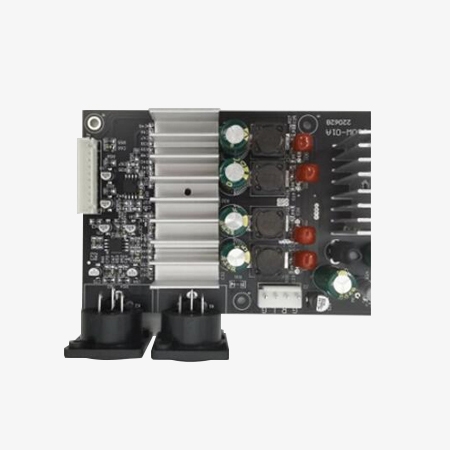The SISCO professional high-watt audio amplifier features a metal chassis and offers optional European or American plug types, making it ideal for stage performances, conference rooms, and KTV venues. It delivers superior sound quality and reliable performance for a wide range of audio applications.

Intelligent Protection and Performance Optimization
- Rapid Cooling for Immersive Sound: Faster, more stable, quieter cooling for a more powerful, immersive experience.
- Active Noise Reduction: Operating noise stays within a 30dB range when powered on.
- 5-Stage Intelligent Protection: Includes clip limit protection, overload protection, thermal protection, short-circuit protection, and DC protection.

Structural Design and Functional Features
- 420mm Metal Chassis: Slim yet sturdy and lightweight, designed to fit the standard 1U height.
- XLR Balanced Input: Enhances signal-to-noise ratio and improves dynamic sound detail.
- Universal Voltage Capacitor Enhancement: The high power amplifier supports global AC input voltage from 100V to 240V.
Applications
SISCO high watt audio power amplifier is a versatile device, ideal for stage performances, wedding ceremonies, conference speeches, and home entertainment. Equipped with high-fidelity Class AB/H circuits, it ensures pure, lossless sound quality and supports parallel connection of multiple amplifiers for greater flexibility. Its advanced cooling system prevents overheating, while intelligent chips ensure stable and reliable operation for a seamless audio experience.

Stage Performance

Conference Speech

Wedding Ceremony

Family Entertainment
| Model | SISCO-PA-X100 |
| Sensitivity | 0.775V |
| Audio Frequency Response | 20Hz-20KHz ± 0.25dB |
| Damping | ≥800 |
| Signal-to-Noise Ratio | >100dB |
| Impedance | 20KΩ/10KΩ |
| Transient Response | 30V/US |
| Phase Response | >60dB/1KHZ |
| Power | 8Ω 150W |
| Weight | 2.42kg |
Dimensions (mm)

Q1: What is gain in a power amplifier?
A1: Gain in a power amplifier refers to the ratio of the amplifier's output signal power, voltage, or current to its corresponding input signal. It is typically expressed in decibels (dB) and indicates how much the amplifier boosts the strength of the input signal. Voltage gain, for example, is calculated as the ratio of the output voltage to the input voltage, often represented logarithmically as 20 log10 (Vout / Vin ). A higher gain means the amplifier can produce a stronger output signal for a given input. However, excessive gain can lead to distortion or instability, so it must be managed carefully to ensure the output signal remains clear and true to the input while achieving the desired amplification.
Q2: What is the difference between voltage amplifiers and power amplifiers?
A2: The primary difference between voltage amplifiers and power amplifiers lies in their purpose and output capabilities. Voltage amplifiers are designed to increase the voltage level of a signal, emphasizing signal amplitude without necessarily driving large currents or powering loads. They are typically used in preamplification stages to boost weak signals for further processing.
In contrast, power amplifiers focus on delivering sufficient power (a combination of voltage and current) to drive heavy loads, such as loudspeakers. Power amplifiers take the amplified signal from voltage amplifiers and strengthen it to provide the energy required for real-world applications, like sound production. Essentially, voltage amplifiers handle signal preparation, while power amplifiers ensure that signal can drive a load effectively.
Q3: What are amplifier classes (Class A, B, AB, D)?
A3: Amplifier classes refer to the design and operation methods of amplifiers, each with distinct characteristics in efficiency, linearity, and power handling. Class A amplifiers operate with a constant current flow through the output transistors, offering excellent linearity and sound quality but low efficiency due to high heat generation. Class B amplifiers improve efficiency by using two transistors that each handle half of the waveform, but this can cause distortion at the waveform crossover point. Class AB combines elements of A and B, with slightly overlapping transistor operation to reduce distortion while maintaining better efficiency than Class A. Class D amplifiers, often called digital amplifiers, use high-frequency switching (pulse-width modulation) to achieve extremely high efficiency and compact designs, making them popular for portable and high-power applications, though they may require additional filtering for audio fidelity. Each class balances trade-offs in performance, efficiency, and complexity based on the application.
Tips: how does a power amplifier work?
A power amplifier works by taking a weak input signal, usually from a preamplifier or audio source, and amplifying it to a level sufficient to drive a load, such as a speaker or another high-power device. It achieves this by using power transistors or similar components that modulate a higher power source (from a power supply) in proportion to the input signal. The amplifier's circuitry ensures the output signal is an accurate, amplified reproduction of the input, while also maintaining impedance matching with the load for efficient power transfer. Depending on its class (e.g., A, B, AB, D), the amplifier optimizes efficiency, linearity, and heat management to ensure clear, undistorted output while meeting the specific requirements of the application.
Thank you for buying industrial test and measurement equipment on SISCO.com, all products sold by SISCO and the partner cover a 12 months warranty, effective from the date of receiving the products.
What is covered?
SISCO is responsible for providing free spare parts, and free technical support to assist the customer to repair the defective products until the problem is solved.
What is not covered?
- Product purchased from anyone other than a SISCO store or a SISCO authorized reseller.
- Expendable parts.
- Routine cleaning or normal cosmetic and mechanical wear.
- Damage from misuse, abuse or neglect.
- Damage from use of parts other than SISCO approved.
- Damage from use outside the product’s usage or storage parameters.
- Damage from use of parts not sold by SISCO.
- Damage from modification or incorporation into other products.
- Damage from repair or replacement of warranted parts by a service provider other than a SISCO authorized service provider.
- Damage caused by the application environment not meeting the product usage requirements and the failure to perform preventive maintenance.

